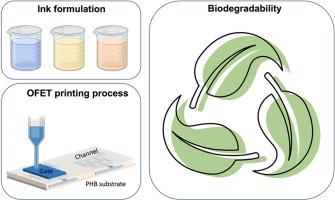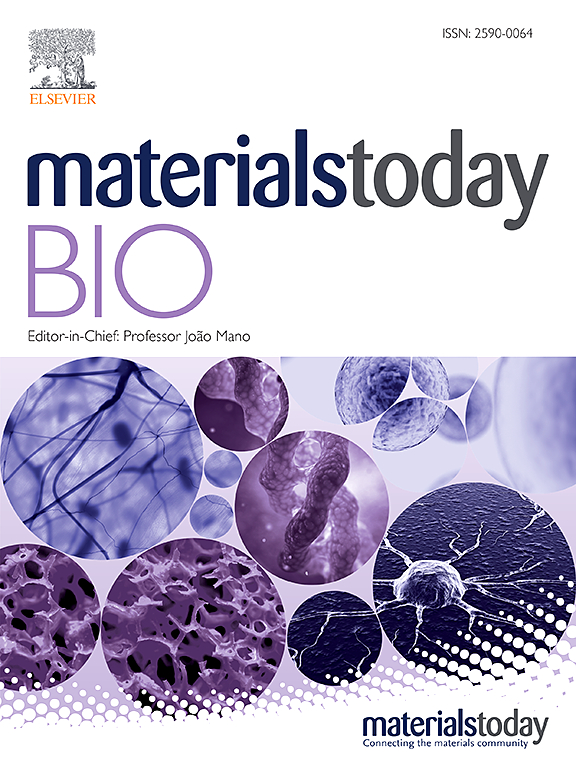All-organic transistors printed on a biodegradable and bioderived substrate for sustainable bioelectronics
IF 8.7
1区 医学
Q1 ENGINEERING, BIOMEDICAL
引用次数: 0
Abstract
Biodegradable electronics is an incipient need in order to mitigate the alarming increase of electronic waste worldwide caused by capillary penetration of electronic devices and sensors. Flexibility, solution processability, low capital expenditure, and energy-efficient processes, which are distinctive features of organic printed electronics, have to be complemented by a sustainable sourcing and end-of-life of materials employed. This requirement calls for solutions where materials, especially substrates that typically represent the largest volume, can be biodegraded in the environment with no harm, yet assuring that no precious resources are dispersed. In this work, the bioderived and biodegradable biopolymer polyhydroxybutyrate (PHB) was used as a substrate, cast from an acetic acid solution, for all-organic field effect transistors (OFETs) based on an inkjet printed polymer semiconductor. The OFETs showed small device-to-device variation, a proper current modulation with ION/IOFF of about 1.2·103, mobility values as high as 0.07 cm2/Vs in saturation regime and channel length/width normalized leakage currents in the order of nA, which remained almost unaltered also after intensive mechanical stresses upon bending and rolling. Such mechanical stability and flexibility, together with the biodegradability and bioderivation, make PHB an appealing candidate for the development of sustainable printed bioelectronics, with widespread future applications in the biomedical and food packaging sector.

印制在可生物降解和生物衍生基底上的全有机晶体管,实现可持续生物电子学
可生物降解的电子产品是一种新的需求,以缓解电子设备和传感器的毛细渗透造成的全球电子垃圾的惊人增长。灵活性、解决方案的可加工性、低资本支出和高能效工艺是有机印刷电子产品的显著特点,但还必须辅之以可持续的材料采购和报废处理。这一要求要求解决方案中的材料,尤其是体积最大的基材,能够在环境中进行生物降解而不会对人体造成伤害,同时确保不会分散宝贵的资源。在这项研究中,利用生物衍生和可生物降解的生物聚合物聚羟基丁酸酯(PHB)作为基底,从醋酸溶液中浇铸出基于喷墨打印聚合物半导体的全有机场效应晶体管(OFET)。这种场效应晶体管的器件与器件之间的差异很小,具有适当的电流调制(ION/IOFF 约为 1.2-103),在饱和状态下的迁移率值高达 0.07 cm2/Vs,沟道长度/宽度归一化漏电流为 nA 量级,即使在弯曲和滚动过程中承受高强度机械应力后也几乎保持不变。这种机械稳定性和柔韧性以及生物降解性和生物活化性使 PHB 成为开发可持续印刷生物电子学的理想候选材料,未来将广泛应用于生物医学和食品包装领域。
本文章由计算机程序翻译,如有差异,请以英文原文为准。
求助全文
约1分钟内获得全文
求助全文
来源期刊

Materials Today Bio
Multiple-
CiteScore
8.30
自引率
4.90%
发文量
303
审稿时长
30 days
期刊介绍:
Materials Today Bio is a multidisciplinary journal that specializes in the intersection between biology and materials science, chemistry, physics, engineering, and medicine. It covers various aspects such as the design and assembly of new structures, their interaction with biological systems, functionalization, bioimaging, therapies, and diagnostics in healthcare. The journal aims to showcase the most significant advancements and discoveries in this field. As part of the Materials Today family, Materials Today Bio provides rigorous peer review, quick decision-making, and high visibility for authors. It is indexed in Scopus, PubMed Central, Emerging Sources, Citation Index (ESCI), and Directory of Open Access Journals (DOAJ).
 求助内容:
求助内容: 应助结果提醒方式:
应助结果提醒方式:


